If you were to order them on a menu, Hindbeh, Hindiba, or Hindbeh b'Zeit will all probably arrive at your table looking like the same thing: a bowl of cooked dandelions with caramelized onions. Or maybe it's wild chicory with fried onions?Whatever you call it, you're in for a treat, because this is possibly my all-time favorite dandelion recipe.
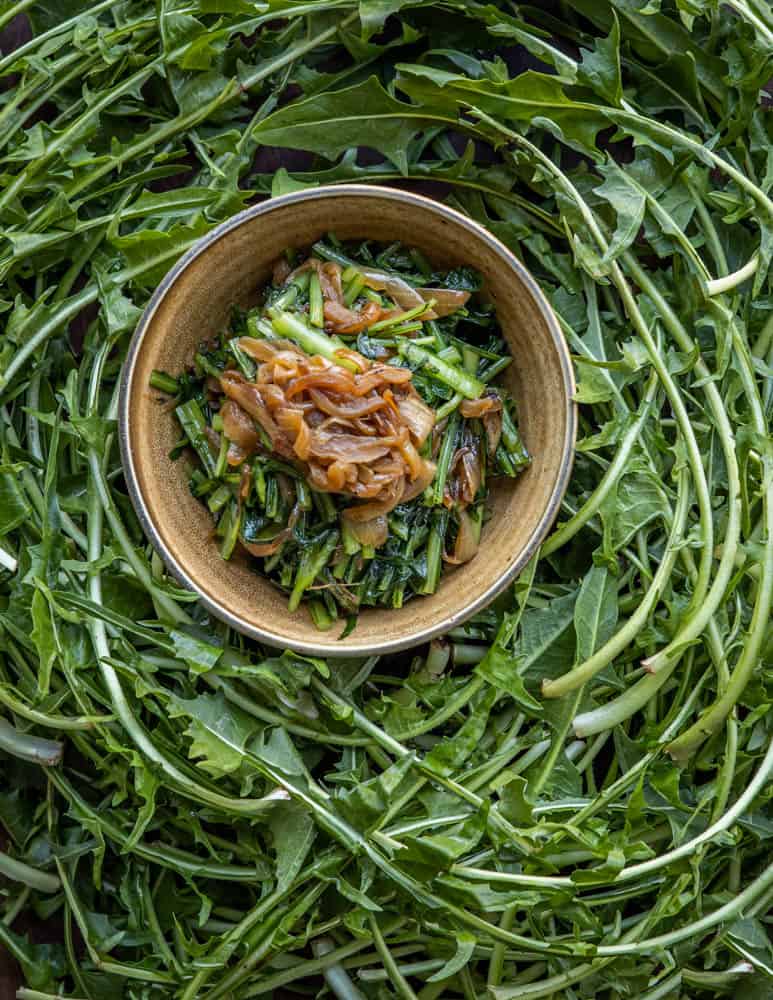
If you crave the aggressive aster-taste of dandelions and their relatives like I do, heck, even if you hate dandelions but have lots of nettles or another green you like, you're going to want to try this, as it's arguably one of the most famous dishes from the Levant relying on wild greens.
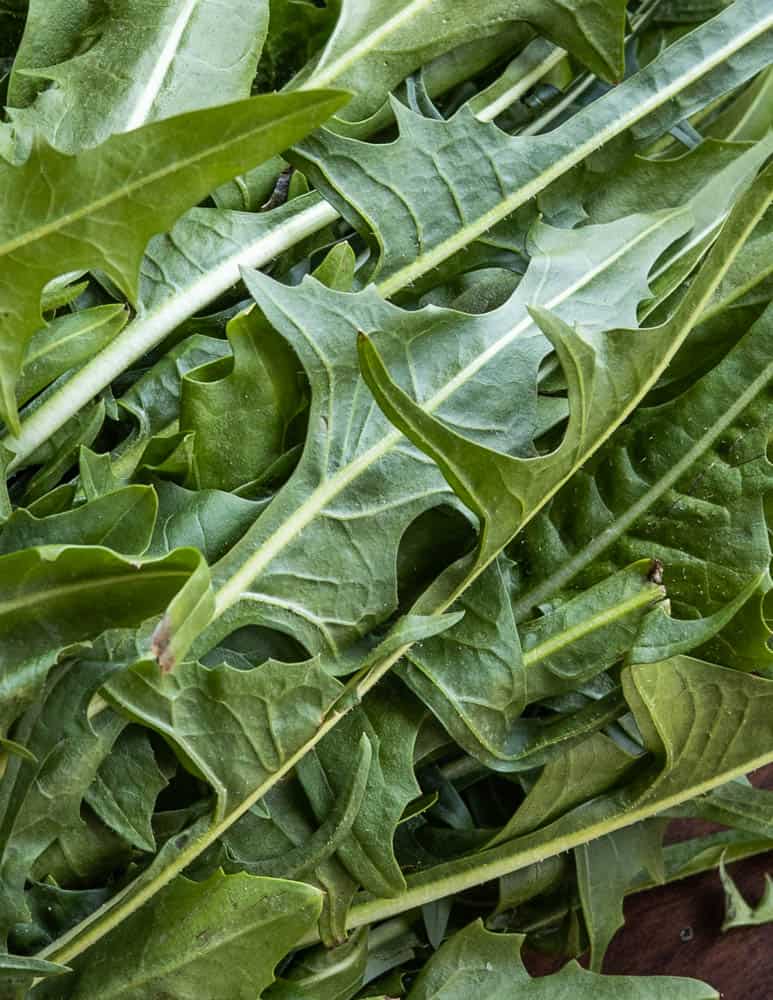
A famous dish from Lebanon

Most sources I look at specifically say it's from Lebanon, but since tasty foods so often diffuse into the surrounding area, I'd suspect other places in the region enjoy it too. Quick aside: sochan, another strong tasting aster, is also excellent here.
Hindbeh is also one of the easiest dishes of greens I've ever made. There's about 5 ingredients: wild greens, onions, olive oil, a pinch of cumin, lemon—that's it.
It's also a fun one to share with you since it's a sneak peak from my upcoming book: The Forager Chef's Book of Flora. In the book I have to keep things more brief, but this dish has so much history I just had to share a little more on it.

Sure, it's a humble (and delicious!) bowl of bitter dandelions and caramelized onions, the bitter and sweet playing off each other in a novel way for me.
But, Hindbeh is also a prime example of one of the ways I can tell that a dish has a strong amount of cultural significance, without having ever set a foot in the place it's from (more on that in a moment).
In the book, I wrote this recipe with dandelions or other greens (modern recipes may call for kale— Philistines!) but the breadcrumb trails I saw here and there told me wild chicory specifically Chicorium endiva, C. intybus and probably other similar relatives were likely the original ancestral plant(s) used in the dish. Take these notes with a grain of salt though, as I can't be certain.
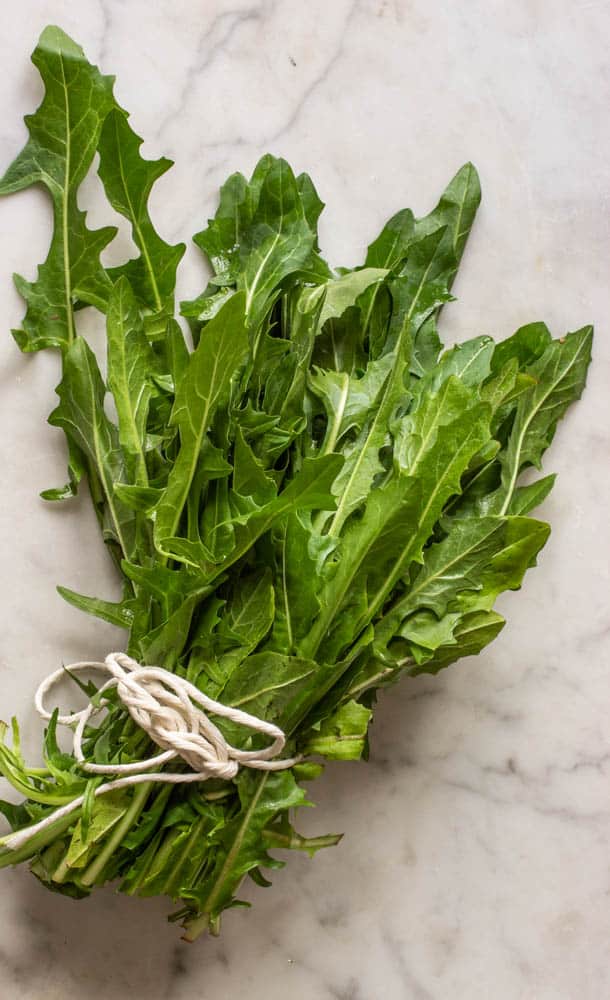
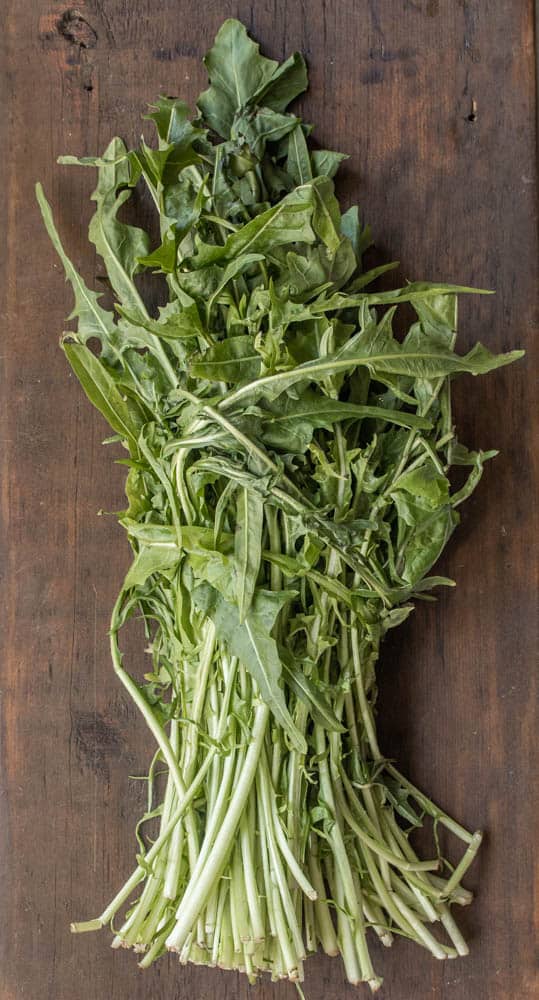
I'm lucky to be close to the greatest Middle Eastern Market in the Midwest where I live (Holy Land!) and, last week when I was craving some sunshine in the form of lamb dolmas, hummus, block feta and kashkaval (a delicious semi-soft milk cheese akin to pecorino Toscano) I got a great surprise.
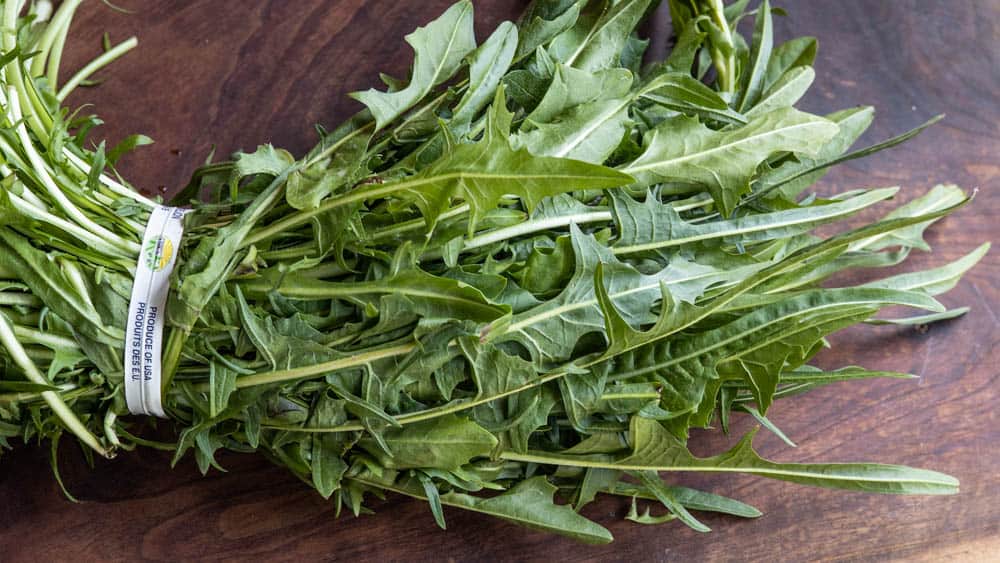
Chicory and Dandelions
Nestled next to the herbs, figs, pomegranates and green chickpeas was the most beautiful bouquet of dandelions my little chef's eyes have ever seen. I knew right away these were no ordinary dandelions though.
First, they were giant compared to the common red-stemmed cultivated dandelion I'm used to seeing at coops, over a foot long, with a far more generous amount of thick, juicy white stem than any cultivated dandelion that I've seen.
Then there were the beautifully elongated leaves, the mature ones coming to a thin point at the end, like the rusted green bronze of Babylonian spears.
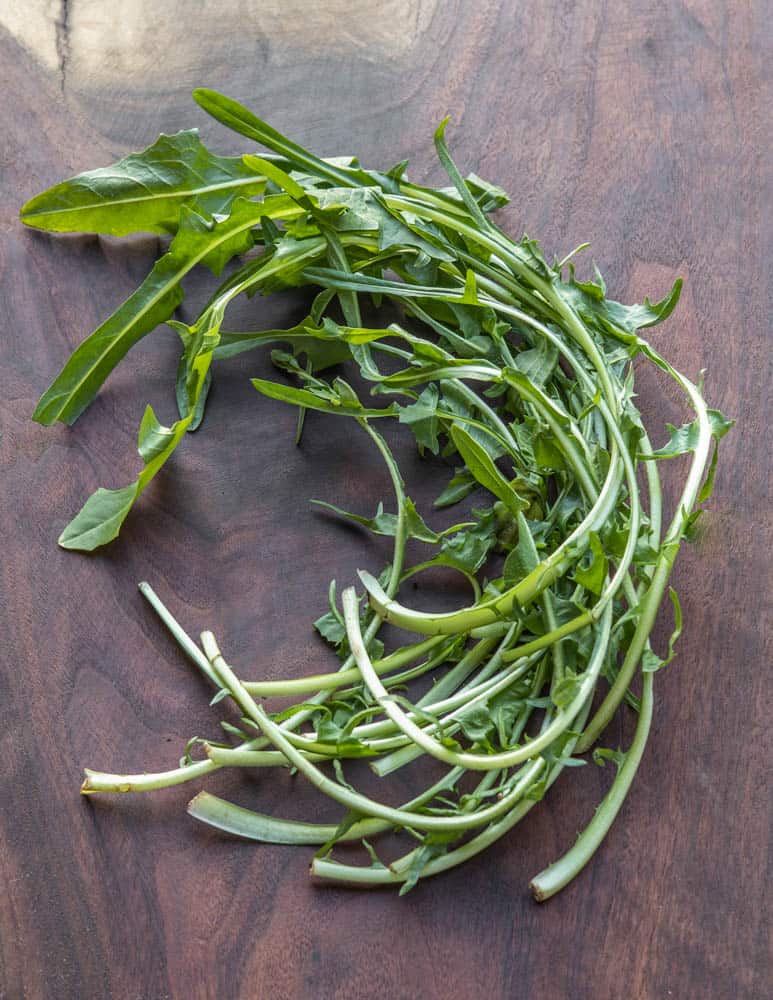
Hindbeh Etymology
Even more interesting than the how they looker was their name. Pushing aside a few greens freshly sprayed from the veggie sprinkler, I smiled when I saw a hand-scribbled price tag with the word "Hindbeh". If they're truly the (Chicorium endiva or whatever exact species) traditionally used to make the dish I can't tell you, but whatever they are, they're not dandelions and they're damned close, so they're good enough for me.
One of the other common names for the dish is Hindbeh b'Zeit, which translates to "Hindbeh with oil" and should also say another thing about the dish: don't be stingy with the good oil!
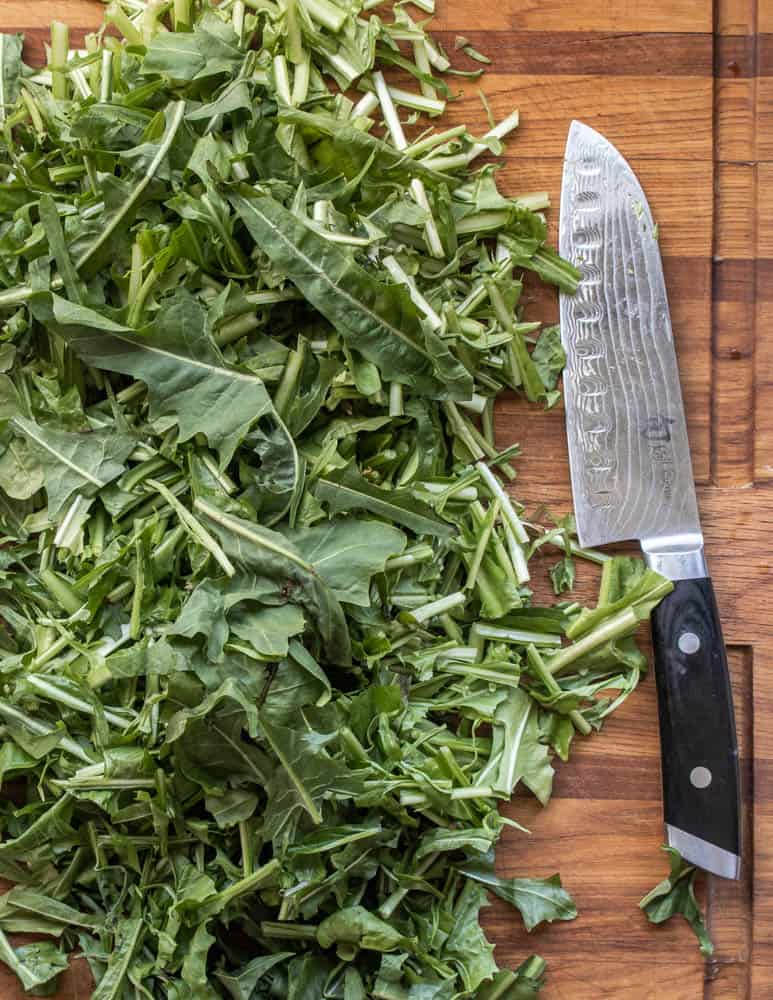
Back to the name Hindbeh and dishes of cultural significance. One thing I kept seeing while researching and writing the book was an overlap of the names between certain ingredients (mostly plants) and finished dishes including them, or occasionally products derived from the ingredient in question.
Humans are creatures of habit and repetition, and, It follows from there that when an ingredient is used heavily, it might not be uncommon for the name of a traditional dish and the ingredient it comes from to eventually merge to have the same name. The linguistic merging seems an endearingly logical progression, the duality offering a hint of deeper flavors in a bowl of dandelions and onions than just bitter and sweet.
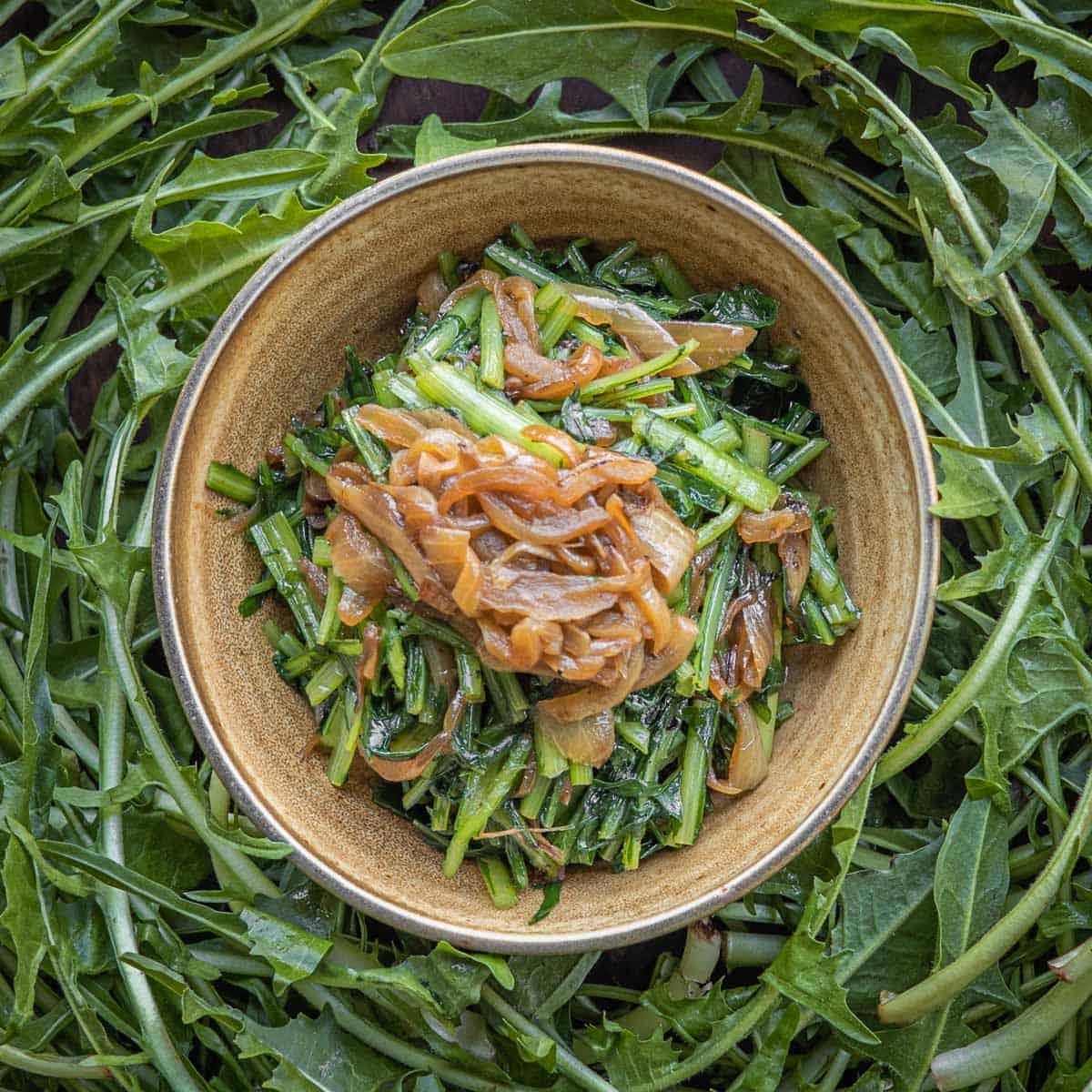
Lebanese Dandelions with Caramelized Onions (Hindbeh)
Equipment
- 1 1 gallon stock pot
- 1 10 inch saute pan
Ingredients
- 1 large yellow onion
- 2 tablespoons extra virgin olive oil, plus more for serving
- Kosher salt and fresh-ground black pepper
- 8 ounces 225 g fresh dandelion greens or other strong-tasting (not necessarily bitter) wild greens
- A good pinch of fresh ground cumin
Instructions
- Cut the top and bottom from the onion, remove the skin, and halve it top-to-bottom. Set the halves, cut-sides down, on a cutting board, and halve them through the equator. Slice the onion into 1-inch (2.5 cm) julienne, as thin as you can.
- In a 10-inch (26 cm) skillet or similar wide pan, heat the lard or oil until very hot, then add the onion and turn the heat down to medium. Season with a pinch of salt and cook for 20 to 30 minutes, stirring occasionally, until the onion is deeply browned and aromatic, deglazing with a tablespoon of water as needed if the pan threatens to dry out (I like my onion quite dark).
- Remove half of the onion and reserve.
- Meanwhile, cook the greens in salted water until they’re tender and taste good to you, then shock in cold water, drain, squeeze out excess water, and coarsely chop.
- Add the greens to the pan with the onion, mix and warm them through, adding the cumin and a little water if needed to moisten.
- Taste and correct the seasoning for salt and pepper, then top with the reserved onion and serve hot with lemon wedges and drizzles of extra virgin olive oil.

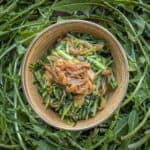
Cynthia
These were delicious! It is the little short window of the year when dandelions are up and not yet too bitter. I always stop weeding them from the garden in the late summer so I have enough coming up in the spring to dig into. So today we had these for lunch. I had some mini penne pasta noodles leftover from last night and, based on the recipe saying to squeeze lemon juice on them, I steamed the pasta over the water I was heating to cook the greens. Then while the greens cooked I melted some cream cheese into the pasta along with the zest of the lemons I had cut for squeezing. We served the greens and onions on top of the pasta. It made a wonderful lunch.
Alan Bergo
Thanks Cynthia, yes, the best dandelions will be the youngest.
Sara
oooh, I bet the cream cheese was the perfect complement to the bitter greens.
Will K.
I love the idea of caramelized onion with greens, seasoned with cumin. I've got a recipe for carrot tops (I use young wild carrot green, aka "Queen Ann's lace") that sounds similar, with exception of adding chickpeas and a squeeze of lemon at the end. I'm definitely going to try this.
Dimitri Magiasis
I loved it! I tried this with Asiatic Hawk's Beard (Youngia japonica), another edible bitter herb in the dandelion tribe. I served this yesterday at a potluck, along with and Horta (H is pronounced like a cat's his sound), a common wild bitter greens dish that is made in Greece. The greeks will take these bitter herbs, such as dandelion, and parboil them in water for 5-15 minutes (my mom said to do it longer, but I don't think it's necessary) until the bitterness is substantially lower and the greens are tender. Then strain the water out and add lemon, olive oil, and salt to taste (usually has a good amount of sour flavor). Both dishes were loved yesterday for different reasons. Thanks!
Alan Bergo
Glad you liked it Dimitri. As my girlfriends family is half Greek, we eat plenty of horta here, I typically leave the green whole and long when making horta so they can be curled up like noodles on a fork.
VELMA STERENBERG
Thanks for inspiration Alan. Won't be seeing any wild greens up here till late May or June, but think I will be adding fireweed (Epilobium angustifolium) and Plantain (Plantago major) to the mix. Wondering what a hint of wild chives (Allium Schoenoprasum), would do; ours up here are very strong. Simple is usually better.
I'll be checking out the the taiga meadows for other bitter greens to try. Maybe even throw in a few spruce or larch tips for texture variant.
Louis Vogel
Would this work with Garlic Mustard ?
Alan Bergo
Possibly but it will be quite bitter.
Karina Rosenberg
The snows are melting in Québec. Can't wait to go harvesting dandelions this spring. This sounds like a delicious alternative to my annual spring ritual of dandelions and lardons salad.
Judy K
This looks mighty tasty! I'll probably give it a try with the nettles that will soon be available, and perhaps a little garlic mustard, since I find its taste generally too bitter for my palate. I'm also happy to have another thing to put on the list for my next trip to the Holy Land Deli--kashkaval.
Sylvie
Italian dandelion is a chicory. Most common is the red stem one. If you saw it growing you would know by its flowers and its roots that is is a chicory, but yes the leaves look like dandelion. And so it generally just sold as "dandelion". Love the simplicity of the dish m- will try it with my red-stemmed Italian dandelion
Tammie
sounds yummy, thank you.
I love your blogs background photo. talk about eye candy!
William McDuff
Thanks for the recipe I'll be trying it when the dandelions are ready in my area.
Nina
Oh my lands! That sounds so good. I love dandelion greens, chicory and nettles; but perhaps Swiss Chard might be good fixed this way too . . . maybe? Can't wait to try this recipe. Thank you.